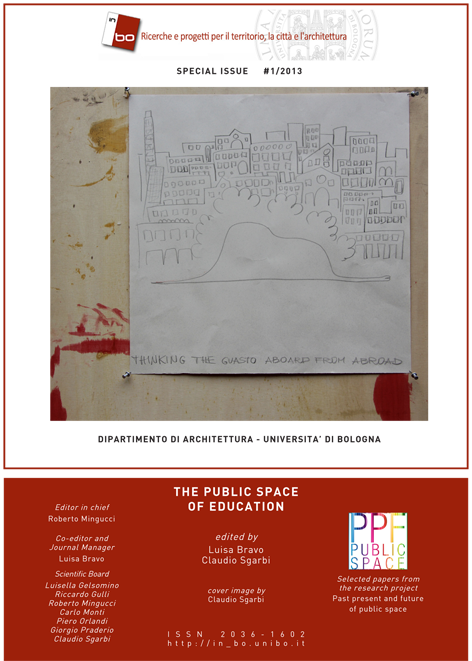The Garden of Guasto in the Historic City of Bologna
DOI:
https://doi.org/10.6092/issn.2036-1602/3715Keywords:
public space, Giardino del Guasto, Bologna, Rino FilippiniAbstract
In 1506 Giovanni II Bentivoglio, undisputed lord of Bologna, was forced to flee, with all his household, by gunfire of the French allies with Pope Julius II Della Rovere. The building, first used by the Cardinal Legate, was destroyed to its foundations and the bricks reused. Anything that could not be taken away was piled up to create a hill and where the park was located where now stands the palace and the garden of failure.
For over two centuries nobody built where there were the ruins of the Bentivoglio, only the Municipality erected his Theatre, opened in 1763. The pile of debris left on the back of the theater, became a dumping ground, where citizens threw all the material that was no longer usable. During XIX century, the area was bounded with the existing selenite retaining walls.
During the WWII war, with the construction of the air-raid shelter, the hill suffered a further rise, re-using the land available from tunneling of the refuge. Under the garden there is still a refuge today, an extremely fascinating space, made up of corridors and galleries that protected the city of Bologna during bombing.
The area was virtually abandoned, used as a city dump, until 1972, when the Municipality of Bologna decided to work on the rehabilitation of the area called “Guasto” (debris). The task was entrusted to the architect Rino Filippini. Since 1999, the Municipality has undertaken works to upgrade and recovery of the garden, in collaboration with the Association Il Giardino del Guasto.
Downloads
Published
How to Cite
Issue
Section
License
Copyright (c) 2013 Marco Ferrari
Copyrights and publishing rights of all the texts on this journal belong to the respective authors without restrictions.
This journal is licensed under a Creative Commons Attribution-NonCommercial 4.0 International License (full legal code).
See also our Open Access Policy.
Metadata
All the metadata of the published material is released in the public domain and may be used by anyone free of charge. This includes references.
Metadata — including references — may be re-used in any medium without prior permission for both not-for-profit and for-profit purposes. We kindly ask users to provide a link to the original metadata record.







